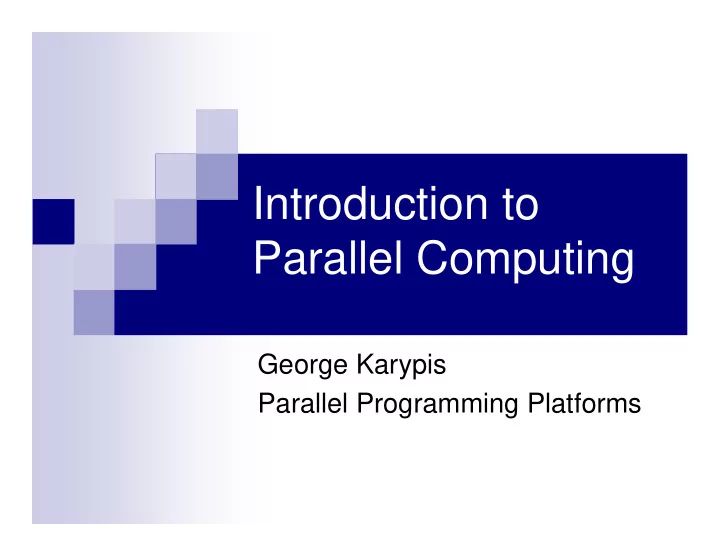

Introduction to Parallel Computing George Karypis Parallel Programming Platforms
Elements of a Parallel Computer � Hardware � Multiple Processors � Multiple Memories � Interconnection Network � System Software � Parallel Operating System � Programming Constructs to Express/Orchestrate Concurrency � Application Software � Parallel Algorithms Goal: Utilize the Hardware, System, & Application Software to either � Achieve Speedup: T p = T s /p � Solve problems requiring a large amount of memory.
Parallel Computing Platform � Logical Organization � The user’s view of the machine as it is being presented via its system software � Physical Organization � The actual hardware architecture � Physical Architecture is to a large extent independent of the Logical Architecture
Logical Organization Elements � Control Mechanism � SISD/SIMD/MIMD/MISD � Single/Multiple Instruction Stream & Single/Multiple Data Stream � SPMD: Single Program Multiple Data
Logical Organization Elements � Communication Model � Message-Passing � Shared-Address Space � UMA/NUMA/ccNUMA
Physical Organization � Ideal Parallel Computer Architecture � PRAM: Parallel Random Access Machine � PRAM Models � EREW/ERCW/CREW/CRCW � Exclusive/Concurrent Read and/or Write � Concurrent Writes are resolved via � Common/Arbitrary/Priority/Sum
Physical Organization � Interconnection Networks (ICNs) � Provide processor-to-processor and processor-to-memory connections � Networks are classified as: � Static � Dynamic � The network consists of � Consist of a number of switching elements that the point-to-point links various processors attach to � direct network � indirect network � Historically used to link � Historically used to link processors-to-memory processors-to-processors � shared-memory systems � distributed-memory system
Static & Dynamic ICNs
Evaluation Metrics for ICNs Diameter � � The maximum distance between any two nodes Smaller the better. � Connectivity � � The minimum number of arcs that must be removed to break it into two disconnected networks Larger the better � � Measures the multiplicity of paths � Bisection width � The minimum number of arcs that must be removed to partition the network into two equal halves. Larger the better � � Bisection bandwidth � Applies to networks with weighted arcs—weights correspond to the link width (how much data it can transfer) � The minimum volume of communication allowed between any two halves of a network Larger the better � Cost � � The number of links in the network Smaller the better �
Metrics and Dynamic Networks
Network Topologies � Bus-Based Networks � Shared medium � Information is being broadcasted � Evaluation: � Diameter: O(1) � Connectivity: O(1) � Bisection width: O(1) � Cost: O(p)
Network Topologies � Crossbar Networks � Switch-based network � Supports simultaneous connections � Evaluation: � Diameter: O(1) � Connectivity: O(1)? � Bisection width: O(p)? � Cost: O(p 2 )
Network Topologies � Multistage Interconnection Networks
Multistage Switch Architecture Pass-through Cross-over
Connecting the Various Stages
Blocking in a Multistage Switch Routing is done by comparing the bit-level representation of source and destination addresses. -match goes via pass-through -mismatch goes via cross-over
Network Topologies � Complete and star-connected networks.
Network Topologies � Cartesian Topologies
Network Topologies � Hypercubes
Network Topologies � Trees
Summary of Performance Metrics
Physical Organization � Cache Coherence in Shared Memory Systems � A certain level of consistency must be maintained for multiple copies of the same data � Required to ensure proper semantics and correct program execution � serializability � Two general protocols for dealing with it � invalidate & update
Invalidate/Update Protocols
Invalidate/Update Protocols � The preferred scheme depends on the characteristics of the underlying application � frequency of reads/writes to shared variables � Classical trade-off between communication overhead (updates) and idling (stalling in invalidates) � Additional problems with false sharing � Existing schemes are based on the invalidate protocol � A number of approaches have been developed for maintaining the state/ownership of the shared data
Communication Costs in Parallel Systems � Message-Passing Systems � The communication cost of a data-transfer operation depends on: � start-up time: t s � add headers/trailer, error-correction, execute the routing algorithm, establish the connection between source & destination � per-hop time: t h � time to travel between two directly connected nodes. � node latency � per-word transfer time: t w � 1/channel-width
Store-and-Forward & Cut-Through Routing
Cut-through Routing Deadlocks Messages 0, 1, 2, and 3 need to go to nodes A, B, C, and D, respectively
Communication Model Used for this Class � We will assume that the cost of sending a message of size m is: � In general true because t s is much larger than t h and for most of the algorithms that we will study mt w is much larger than lt h
Routing Mechanisms � Routing: � The algorithm used to determine the path that a message will take to go from the source to destination � Can be classified along different dimensions � minimal vs non-minimal � deterministic vs adaptive
Dimension Ordered Routing � There is a predefined ordering of the dimensions � Messages are routed along the dimensions in that order until they cannot move any further � X-Y routing for meshes � E-cube routine for hypercubes
Topology Embeddings � Mapping between networks � Useful in the early days of parallel computing when topology specific algorithms were being developed. � Embedding quality metrics � dilation � maximum number of lines an edge is mapped to � congestion � maximum number of edges mapped on a single link
Mapping a Cartesian Topology onto a Hypercube Cool things ☺
Mapping a Cartesian Topology onto a Hypercube
Recommend
More recommend